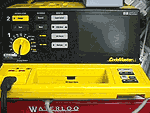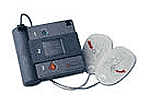Defibrillation
What is defibrillation?
Defibrillation is the sending of a powerful electric shock through the heart. It is used when the heart stops beating effectively, either by beating erratically or stopping entirely. This shock is designed to pass through the heart and restart the heart's natural beating rhythm.
What is a defibrillator?
Defibrillation is accomplished with a device called a defibrillator. Doctors and nurses use the defibrillator by holding electric paddles on the patient's chest or placing pads on the patient's chest. The defibrillator generates the electrical shock that is passed to the patient through the paddles or pads.
When is defibrillation used?
Defibrillation is used when a patient's heart has stopped beating effectively.
Does defibrillation always restart the heart?
If the heart has lost all of its electrical activity or is so severely damaged that it no longer has enough muscle to pump blood through the body, defibrillation will usually not be successful in restarting the heart.
Does defibrillation always restore the heart's rhythm?
No. Unfortunately, most people die when the heart has stopped beating. However, the defibrillator is the best chance to restart the heart and restore the patient's heart rhythm.
Should defibrillation be used on all patients when their heart develops a life threatening rhythm?
This is a discussion the patient and family should have with the attending physician and the ICU staff. Since many people will not benefit from use of the defibrillator, make sure a discussion has been held with the doctor before choosing to use this device.
Does defibrillation hurt?
Not usually, because the patient is not awake. If awake, patients receive sedation and pain medication prior to the defibrillation and they rarely recall the event.
Are there any potential complications associated with defibrillation?
Sometimes the electrical current passing through the paddles produces skin irritation.
What is an automatic external defibrillator (AED)?
A new device, the automatic external defibrillator (AED), is being used in many places outside the ICU. It is simple to use and does not require a doctor or nurse to operate the device. If a patient is to be resuscitated after the heart stops beating effectively, defibrillation is often the only chance to survive. The shock should be delivered as soon as possible. This is why many facilities beyond hospitals, such as airplanes, shopping malls and health clubs are adding AEDs to emergency supplies.
Defibrillator

Automatic External Defibrillator (AED)
